List of Russian monarchs
This is a list of all reigning monarchs in the history of Russia. It includes the titles Prince of Novgorod, Grand Prince of Kiev, Grand Prince of Vladimir, Grand Prince of Moscow, Czar of All Rus' (Russia), and Emperor of All Russia. The list begins with the semi-legendary Rurik, Prince of Novgorod, sometime in the mid 9th century (c. 862) and ends with the Emperor of All Russia Nicholas II who abdicated in 1917, and was executed with his family in 1918.
| Monarchy of Russia | |
|---|---|
 | |
_(p)1886%D0%B3_%D0%93%D0%98%D0%9C_e1t3.jpg.webp) Tree of Russian rulers | |
| Details | |
| Style | His/Her Imperial Majesty |
| First monarch | Rurik (as Prince) |
| Last monarch | Nicholas II (as Emperor) |
| Formation | 862 |
| Abolition | 15 March 1917 |
| Residence | Winter Palace, Moscow Kremlin |
| Appointer | Hereditary |
| Pretender(s) | |
The vast territory known today as Russia covers an area that has been known historically by various names, including Rus', Kievan Rus',[1] the Grand Duchy of Moscow, the Czardom of Russia and the Russian Empire, and the sovereigns of these many nations and throughout their histories have used likewise as wide a range of titles in their positions as chief magistrates of a country. Some of the earliest titles include Kniaz and Velikiy Kniaz, which mean "Prince" and "Great Prince" respectively but are often rendered as "Duke" and "Grand Duke" in Western literature; then the title of Czar, meaning "Caesar", which was disputed to be the equal of either a king or emperor; finally culminating in the title of Emperor. According to Article 59 of the 1906 Russian Constitution, the Russian Czar held several dozen titles, each one representing a region which the monarch governed.
The Patriarchs of Moscow, who were the head of Russian Orthodox Church, also have acted as the leaders of Russia from time to time, usually in periods of political upheaval as during the Polish occupation and interregnum of 1610–13.
Princes of Ancient Rus', 862–1547
Parts of the land that is today known as Russia was populated by various East Slavic peoples from before the 9th century. The first states to exert hegemony over the region were those of the Rus' people, a branch of Nordic Varangians who entered the region occupied by modern Russia sometime in the ninth century, and set up a series of states starting with the Rus' Khaganate circa 830. Little is known of the Rus' Khaganate beyond its existence, including the extent of its territory or any reliable list of its Khagans (rulers).
Princes of Novgorod
Traditionally, Rus' statehood is traced to Rurik, a Rus' leader of Holmgard (later Novgorod, modern Veliky Novgorod), a different Rus' state.
| Name | Lifespan | Reign start | Reign end | Notes | Family | Image |
|---|---|---|---|---|---|---|
Rurik I
| 830 – 879 | 862 | 879 | Founder of Rurik Dynasty | Rurikids |  |
| Oleg of Novgorod Oleg the Seer
| 855 – 912 | 879 | 882 | Relative of Rurik and regent of Rurik's son, Prince Igor | Rurikids | 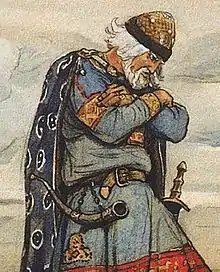 |
Grand Princes of Kiev
Rurik's successor Oleg moved his capital to Kiev (now Ukraine), founding the state of Kievan Rus'. Over the next several centuries, the most important titles were those of the Grand Prince of Kiev and Grand Prince of Novgorod whose holder (often the same person) could claim hegemony.
| Name | Lifespan | Reign start | Reign end | Notes | Family | Image |
|---|---|---|---|---|---|---|
Askold and Dir
| 9th century | 842[2][3][note 1] | 882 | Rus' chieftains and members of Rurik's army | Askold: Kyi |  |
| Oleg of Novgorod Oleg the Seer
| 855 – 912 | 882 | Autumn 912 | Successor of Askold and Dir as a regent of Rurik's son | Rurikids |  |
| Igor I Igor Rurikovich
| 878 – 945 | 913 | Autumn 945 | Son of Rurik | Rurikids |  |
| Olga of Kiev Olga the Wise (Saint Olga)
| 890 – 969 | 945 | 962 | Wife of Igor I and regent of Sviatoslav I | - |  |
| Sviatoslav I Sviatoslav Igorevich
| 942 – 972 | Autumn 945 | March 972 | Son of Igor I and Olga of Kiev | Rurikids | 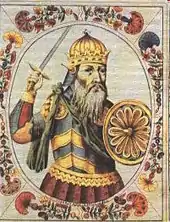 |
| Yaropolk I Yaropolk Svyatoslavich
| 950 – 980 | March 972 | 11 June 980 | Son of Sviatoslav I and Predslava | Rurikids |  |
| Vladimir I Vladimir Syatoslavich (Vladimir the Great)
| 958 – 1015 | 11 June 980 | 15 July 1015 | Son of Sviatoslav I and Malusha Younger brother of Yaropolk I | Rurikids |  |
| Sviatopolk I Sviatopolk Vladimirovich (Sviatopolk the Cursed)
| 980 – 1019 | 15 July 1015 | Autumn 1016 | Son of Vladimir I or Yaropolk I During his reign, Kievan Rus' was conquered by Poland | Rurikids |  |
| Yaroslav I Yaroslav Vladimirovich (Yaroslav the Wise)
| 978 – 1054 | Autumn 1016 | Summer 1018 | Son of Vladimir I and Rogneda of Polotsk | Rurikids |  |
| Sviatopolk I Sviatopolk Vladimirovich (Sviatopolk the Cursed)
| 980 – 1019 | 14 August 1018 | 27 July 1019 | Restored | Rurikids |  |
| Yaroslav I Yaroslav Vladimirovich (Yaroslav the Wise)
| 978 – 1054 | 27 July 1019 | 20 February 1054 | Restored | Rurikids |  |
| Iziaslav I Iziaslav Yaroslavich
| 1024 – 1078 | 20 February 1054 | 15 September 1068 | First son of Yaroslav I and Ingegerd Olofsdotter | Rurikids |  |
| Vseslav Briachislavich Vseslav the Sorcerer
| 1039 – 1101 | 15 September 1068 | 29 April 1069 | Great-grandson of Vladimir I Usurped the Kievan Throne | Rurikids |  |
| Iziaslav I Iziaslav Yaroslavich
| 1024 – 1078 | 2 May 1069 | 22 March 1073 | Restored | Rurikids |  |
| Sviatoslav II Sviatoslav Yaroslavich
| 1027 – 1076 | 22 March 1073 | 27 December 1076 | Third son of Yaroslav I and Ingegerd Olofsdotter | Rurikids | 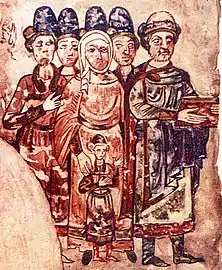 |
| Vsevolod I Vsevolod Yaroslavich
| 1030 – 1093 | 1 January 1077 | 15 July 1077 | Fourth son of Yaroslav I and Ingegerd Olofsdotter | Rurikids |  |
| Iziaslav I Iziaslav Yaroslavich
| 1024 – 1078 | 15 July 1077 | 3 October 1078 | Restored | Rurikids |  |
| Vsevolod I Vsevolod Yaroslavich
| 1030 – 1093 | 3 October 1078 | 13 April 1093 | Restored | Rurikids |  |
| Sviatopolk II Sviatopolk Iziaslavich
| 1050 – 1113 | 24 April 1093 | 16 April 1113 | Son of Iziaslav I | Rurikids |  |
| Vladimir II Vladimir Vsevolodovich (Vladimir Monomakh)
| 1053 – 1125 | 20 April 1113 | 19 May 1125 | Son of Vsevolod I and Anastasia of Byzantium | Rurikids |  |
| Mstislav I Mstislav Vladimirovich (Mstislav the Great)
| 1076 – 1132 | 20 May 1125 | 15 April 1132 | Son of Vladimir II and Gytha of Wessex | Rurikids | .jpg.webp) |
| Yaropolk II Yaropolk Vladimirovich
| 1082 – 1139 | 17 April 1132 | 18 February 1139 | Son of Vladimir II and Gytha of Wessex Younger brother of Mstislav I | Rurikids |  |
| Viacheslav I Viacheslav Vladimirovich
| 1083 – 2 February 1154 | 22 February 1139 | 4 March 1139 | Son of Vladimir II and Gytha of Wessex Younger brother of Mstislav I and Yaropolk II | Rurikids |  |
| Vsevolod II Vsevolod Olgovich
| 1084 – 1146 | 5 March 1139 | 30 July 1146 | Grandson of Sviatoslav II | Rurikids |  |
| Igor II Igor Olgovich
| 1096 – 19 September 1146 | 1 August 1146 | 13 August 1146 | Grandson of Sviatoslav II | Rurikids |  |
| Iziaslav II Iziaslav Mstislavich
| 1097 – 1154 | 13 August 1146 | 23 August 1149 | Son of Mstislav I and Christina Ingesdotter of Sweden | Rurikids |  |
| Yuri I Yuri Vladimirovich (Yuri the Long Hands)
| 1099 – 1157 | 28 August 1149 | Summer 1150 | Son of Vladimir II and Gytha of Wessex Younger brother of Mstislav I, Yaropolk II and Viacheslav I | Rurikids |  |
| Viacheslav I Viacheslav Vladimirovich
| 1083 – 2 February 1154 | Summer 1150 | Summer 1150 | Restored | Rurikids |  |
| Iziaslav II Iziaslav Mstislavich
| 1097 – 1154 | Summer 1150 | Summer 1150 | Restored | Rurikids |  |
| Yuri I Yuri Vladimirovich (Yuri the Long Hands)
| 1099 – 1157 | August 1150 | Winter 1151 | Restored | Rurikids |  |
| Iziaslav II Iziaslav Mstislavich
| 1097 – 1154 | Winter 1151 | 13 November 1154 | Restored | Rurikids |  |
| Viacheslav I Viacheslav Vladimirovich
| 1083 – 2 February 1154 | Spring 1151 | 6 February 1154 | Restored | Rurikids |  |
| Rostislav I Rostislav Mstislavich
| 1110 – 1167 | 1154 | January 1155 | Son of Mstislav I and Christina Ingesdotter of Sweden Younger brother of Iziaslav II | Rurikids |  |
| Iziaslav III Iziaslav Davydovich
| 12th century | January 1155 | 1155 | Grandson of Sviatoslav II | Rurikids |  |
| Yuri I Yuri Vladimirovich (Yuri the Long Hands)
| 1099 – 1157 | 20 March 1155 | 15 May 1157 | Restored | Rurikids |  |
| Iziaslav III Iziaslav Davydovich
| 12th century | 19 May 1157 | December 1158 | Restored | Rurikids |  |
| Mstislav II Mstislav Iziaslavich
| 1125 – 1170 | 22 December 1158 | Spring 1159 | Son of Iziaslav II | Rurikids |  |
| Rostislav I Rostislav Mstislavich
| 1110 – 1167 | 12 April 1159 | 8 February 1161 | Restored | Rurikids |  |
| Iziaslav III Iziaslav Davydovich
| 12th century | 12 February 1161 | 6 March 1161 | Restored | Rurikids |  |
| Rostislav I Rostislav Mstislavich
| 1110 – 1167 | March 1161 | 14 March 1167 | Restored | Rurikids |  |
| Mstislav II Mstislav Iziaslavich
| 1125 – 1170 | 19 May 1167 | 12 March 1169 | Restored | Rurikids |  |
| Gleb I Gleb Yuryevich
| ? – 1171 | 1169 | 1170 | Son of Yuri Vladimirovich | Rurikids |  |
| Mstislav II Mstislav Iziaslavich
| 1125 – 1170 | March 1170 | April 1170 | Restored | Rurikids |  |
| Gleb I Gleb Yuryevich
| ? – 1171 | 1170 | 1171 | Restored | Rurikids |  |
| Vladimir III Vladimir Mstislavich
| 1132 – 1171 | 1171 | 1171 | Son of Mstislav I Younger brother of Iziaslav II and Rostislav I | Rurikids |  |
Grand Princes of Vladimir
By the early 11th century the Rus' state had fragmented into a series of petty principalities which warred constantly with each other. In 1097, the Council of Liubech formalized the federal nature of the Rus' lands. By the 12th century, the Grand Duchy of Vladimir became the dominant principality, adding its name to those of Novgorod and Kiev, culminating with the rule of Alexander Nevsky. In 1169 Vladimir-Suzdal troops took Kiev. This act underlined the declining importance of that city.
| Name | Lifespan | Reign start | Reign end | Notes | Family | Image |
|---|---|---|---|---|---|---|
| Andrey I Andrey Yuryevich (Andrey the Pious)
| 1110 – 1174 | 15 May 1157 | 29 June 1174 | Son of Yuri I Murdered | Rurikids |  |
| Mikhail I Mikhail Yuryevich
| 12th century | 1174 | September 1174 | Son of Yuri I Younger brother of Andrey I | Rurikids |  |
| Yaropolk III Yaropolk Rostislavich
| 12th century | 1174 | 15 June 1175 | Grandson of Yuri I | Rurikids |  |
| Mikhail I Mikhail Yuryevich
| 12th century | 15 June 1175 | 20 June 1176 | Restored | Rurikids |  |
| Vsevolod III Vsevolod Yuryevich (Vsevolod the Big Nest)
| 1154 – 1212 | June 1176 | 15 April 1212 | Son of Yuri I and Helene Younger brother of Andrey I and Mikhail I | Rurikids |  |
| Yuri II Yuri Vsevolodovich
| 1189 – 1238 | 1212 | 27 April 1216 | Son of Vselovod III and Maria Shvarnovna | Rurikids | .jpg.webp) |
| Konstantin of Rostov Konstantin Vsevolodovich
| 1186 – 1218 | Spring 1216 | 2 February 1218 | Son of Vsevolod III and Maria Shvarnovna Elder brother of Yuri II | Rurikids | .jpg.webp) |
| Yuri II Yuri Vsevolodovich
| 1189 – 1238 | February 1218 | 4 March 1238 | Restored | Rurikids | .jpg.webp) |
| Yaroslav II Yaroslav Vsevolodovich
| 1191 – 1246 | 1238 | 30 September 1246 | Son of Vsevolod III and Maria Shvarnovna Younger brother of Yuri II and Konstantin of Rostov | Rurikids | .jpeg.webp) |
| Sviatoslav III Sviatoslav Vsevolodovich
| 1196 – 3 February 1252 | 1246 | 1248 | Son of Vsevolod III and Maria Shvarnovna Younger brother of Yuri II, Konstantin of Rostov and Yaroslav II | Rurikids |  |
| Mikhail Yaroslavich Mikhail Khorobrit
| 1229 – 15 January 1248 | 1248 | 15 January 1248 | Son of Yaroslav II | Rurikids |  |
| Sviatoslav III Sviatoslav Vsevolodovich
| 1196 – 3 February 1252 | 1248 | 1249 | Restored | Rurikids |  |
| Andrey II Andrey Yaroslavich
| 1222 – 1264 | December 1249 | 24 July 1252 | Son of Yaroslav II Elder brother of Mikhail Khorobrit | Rurikids |  |
| Alexander Yaroslavich Alexander Nevsky
| 1221 – 1263 | 1252 | 14 November 1263 | Son of Yaroslav II and Rostislava Mstislavna, daughter of Kievan Rus' Prince Mstislav Mstislavich the Bold Elder brother of Mikhail Khorobrit and Andrey II | Rurikids |  |
| Yaroslav III Yaroslav Yaroslavich
| 1230 – 1272 | 1264 | 1271 | Son of Yaroslav II and Fedosia Igorevna Younger brother of Alexander Nevsky, Andrey II and Mikhail Khorobrit | Rurikids |  |
Vasily Yaroslavich
| 1241 – 1276 | 1272 | January 1277 | Son of Yaroslav II | Rurikids | 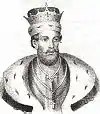 |
Dmitry Aleksandrovich
| 1250 – 1294 | 1277 | 1281 | Son of Alexander Nevsky | Rurikids |  |
| Andrey III Andrey Aleksandrovich
| 1255 – 1304 | 1281 | December 1283 | Son of Alexander Nevsky Younger brother of Dmitry of Pereslavl | Rurikids |  |
Dmitry Aleksandrovich
| 1250 – 1294 | December 1283 | 1293 | Restored | Rurikids |  |
| Andrey III Andrey Aleksandrovich
| 1255 – 1304 | 1293 | 1304 | Restored | Rurikids |  |
| Mikhail Yaroslavich Michael of Tver
| 1271 – 1318 | Autumn 1304 | 22 November 1318 | Son of Yaroslav III and Xenia of Tarusa Murdered | Rurikids |  |
| Yuri III Yuri Danilovich
| 1281 – 1325 | 1318 | 2 November 1322 | Grandson of Alexander Nevsky | Rurikids |  |
| Dmitry Mikhailovich Dmitry the Fearsome Eyes
| 1299 – 1326 | 1322 | 15 September 1326 | Son of Michael of Tver and Anna of Kashin Murdered | Rurikids |  |
Alexander Mikhaylovich
| 1301 – 1339 | 1326 | 1327 | Son of Michael of Tver and Anna of Kashin Younger brother of Dmitry | Rurikids |  |
Alexander Vasilyevich
| 14th century | 1328 | 1331 | Grandson of Andrey II | Rurikids |  |
| Ivan I Ivan Danilovich (Ivan Kalita)
| 1288 – 1340 | 1332 | 31 March 1340 | Grandson of Alexander Nevsky Son of Daniel of Moscow Younger brother of Yuri III | Rurikids |  |
Grand Princes of Moscow
After Alexander Nevsky, the region once again broke up into petty states, though the Grand Duchy of Moscow, founded by Alexander Nevsky's youngest son Daniel, began to consolidate control over the entire Rus' territory in the 15th century, starting the story of Russia. Following the Mongol conquests of the 13th century, all of the Russian principalities paid tribute to the Golden Horde, effectively operating as vassals of the Mongol state. The Russians began to exert independence from the Mongols, culminating with Ivan the Great of Moscow ceasing tribute to the Horde, effectively declaring his independence. His son Vasili III completed the task of uniting all of Russia by eliminating the last few independent states in the 1520s.
| Name | Lifespan | Reign start | Reign end | Notes | Family | Image |
|---|---|---|---|---|---|---|
Daniel Aleksandrovich
| 1261 – 4 March 1303 | 1272 | 4 March 1303 | Son of Alexander Nevsky and Maria | Rurikids | .jpg.webp) |
Yuri Danilovich
| 1281 – 21 November 1325 | 4 March 1303 | 21 November 1325 | Son of Daniel Elder brother of Ivan I | Rurikids |  |
| Ivan I Ivan Danilovich (Ivan Kalita)
| 1288 – 1340 | 21 November 1325 | 31 March 1340 | He was a successor of Alexander of Suzdal as Grand Prince of Vladimir and a successor of Yury of Moscow as Grand Prince of Moscow | Rurikids |  |
| Simeon Ivanovich Simeon the Proud
| 7 November 1316 – 27 April 1353 | 31 March 1340 | 27 April 1353 | Son of Ivan I and Helena | Rurikids |  |
| Ivan II Ivan Ivanovich (Ivan the Fair)
| 30 March 1326 – 13 November 1359 | 27 April 1353 | 13 November 1359 | Son of Ivan I and Helena Younger brother of Simeon of Moscow | Rurikids |  |
| Dmitry Ivanovich Dmitry of the Don
| 12 October 1350 – 19 May 1389 | 13 November 1359 | 19 May 1389 | Son of Ivan II and Alexandra Vasilyevna Velyaminova | Rurikids | 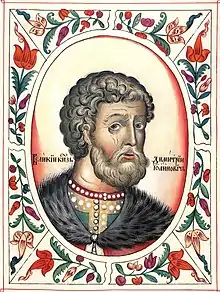 |
| Vasily I Vasily Dmitriyevich
| 30 December 1371 – 27 February 1425 | 19 May 1389 | 27 February 1425 | Son of Dmitry I and Eudoxia Dmitriyevna | Rurikids |  |
| Vasily II Vasily Vasilyevich (Vasily the Dark)
| 10 March 1415 – 27 March 1462 | 27 February 1425 | 30 March 1434 | Son of Vasily I and Sophia of Lithuania | Rurikids |  |
Yuri Dmitriyevich
| 26 November 1374 – 5 June 1434 | 31 March 1434 | 5 June 1434 | Son of Dmitry I and Eudoxia Dmitriyevna Younger brother of Vasily I | Rurikids |  |
| Vasily Yuryevich Vasily the Squint
| 1421 – 1448 | 5 June 1434 | 1435 | Son of Yury of Zvenigorod | Rurikids |  |
| Vasily II Vasily Vasilyevich (Vasily the Dark)
| 10 March 1415 – 27 March 1462 | 1435 | 1446 | Restored | Rurikids |  |
| Dmitry Yuryevich Dmitry Shemyaka
| 15th century | 1446 | 26 March 1447 | Son of Yury of Zvenigorod | Rurikids |  |
| Vasily II Vasily Vasilyevich (Vasily the Dark)
| 10 March 1415 – 27 March 1462 | 27 February 1447 | 27 March 1462 | Restored | Rurikids |  |
| Ivan III Ivan Vasilyevich (Ivan the Great)
| 22 January 1440 – 6 November 1505 | 5 April 1462 | 6 November 1505 | Son of Vasily II and Maria of Borovsk | Rurikids |  |
| Vasily III Vasily Ivanovich
| 25 March 1479 – 13 December 1533 | 6 November 1505 | 13 December 1533 | Son of Ivan III and Sophia Paleologue | Rurikids |  |
| Ivan IV Ivan Vasilyevich (Ivan the Terrible)
| 25 August 1530 – 28 March 1584 | 13 December 1533 | 26 January 1547 | Son of Vasily III and Elena Glinskaya | Rurikids |  |
Tsars of Russia, 1547–1721
Vasili's son Ivan the Terrible formalized the situation by assuming the title Tsar of All Rus' in 1547, when the state of Russia (apart from its constituent principalities) came into formal being.
Dates are listed in the Old Style, which continued to be used in Russia until the revolution.
| Name | Lifespan | Reign start | Reign end | Notes | Family | Image |
|---|---|---|---|---|---|---|
| Ivan IV Ivan Vasilyevich (Ivan the Terrible)
| 25 August 1530 – 28 March 1584 | 26 January 1547 | 28 March 1584 | Son of Vasily III and Elena Glinskaya | Rurikids |  |
Simeon Bekbulatovich
| 16th century – 5 January 1616 | 1575 | 1576 | Muslim-born Khan of Qasim Khanate Proclaimed Grand Prince of All Rus' in 1575 and abdicated within a year | Qasim |  |
| Feodor I Feodor Ivanovich
| 31 May 1557 – 17 January 1598 | 28 March 1584 | 17 January 1598 | Son of Ivan IV and Anastasia Romanovna | Rurikids | .jpg.webp) |
Following the death of the Feodor I, the son of Ivan the Terrible and the last of the Rurik dynasty, Russia fell into a succession crisis known as the Time of Troubles. As Feodor left no male heirs, the Russian Zemsky Sobor (feudal parliament) elected his brother-in-law Boris Godunov to be Tsar. Devastated by famine, rule under Boris descended into anarchy. A series of impostors, known as the False Dmitriys, each claimed to be Feodor's long deceased younger brother; however, only the first impostor ever legitimately held the title of Tsar. A distant Rurikid cousin, Vasili Shuyskiy, also took power for a time. During this period, foreign powers deeply involved themselves in Russian politics, under the leadership of the Vasa monarchs of Sweden and Poland-Lithuania, including Sigismund III Vasa and his son Władysław IV Vasa. As a child, Władysław was even chosen as Tsar by the Seven Boyars, though he was prevented by his father from formally taking the throne. The Time of Troubles is considered to have ended with the election of Michael Romanov to the throne, who established the Romanov dynasty that would rule Russia until the Russian Revolution of 1917.
| Name | Lifespan | Reign start | Reign end | Notes | Family | Image |
|---|---|---|---|---|---|---|
Boris Godunov
| 1551 – 13 April 1605 | 21 February 1598 | 13 April 1605 | Brother-in-law of Feodor I Elected by Zemsky Sobor | Godunov | .jpg.webp) |
| Feodor II Feodor Borisovich
| 1589 – 20 June 1605 | 13 April 1605 | 10 June 1605 | Son of Boris Godunov and Maria Grigorievna Skuratova-Belskaya Murdered | Godunov |  |
| False Dmitriy I Dmitriy Ivanovich
| 1581 – 17 May 1606 | 10 June 1605 | 17 May 1606 | Claiming to be son of Ivan IV, he was the only imposter to actually sit on the throne of a major power Backed by Polish–Lithuanian Commonwealth. Murdered. | Rurikids (claimed) |  |
| Vasily IV Vasily Ivanovich (Vasily Shuysky)
| 22 September 1552 – 12 September 1612 | 19 May 1606 | 17 July 1610 (deposed) | Ninth generation descendant of Andrei II in the male line | Shuysky |  |
Vladislav
| 9 June 1595 – 20 May 1648 | 6 September 1610 | November 1612 (deposed) 14 June 1634 (resigned his claim) | King of Poland since 1632 Son of Sigismund III Vasa and Anne of Austria Elected by the Seven Boyars, never assumed the throne | Vasa |  |
The Time of Troubles came to a close with the election of Michael Romanov as Tsar in 1613. Michael officially reigned as Tsar, though his father, the Patriarch Philaret (died 1633) initially held the real power. However, Michael's descendants would rule Russia, first as Tsars and later as Emperors, until the Russian Revolution of 1917. Peter the Great (reigned 1682–1725), a grandson of Michael Romanov, reorganized the Russian state along more Western lines, establishing the Russian Empire in 1721.
| Name | Lifespan | Reign start | Reign end | Notes | Family | Image |
|---|---|---|---|---|---|---|
| Michael Michael Feodorovich
| 12 July 1596 – 12 July 1645 | 26 July 1613 | 12 July 1645 | Founder of Romanov Dynasty First cousin once removed of Feodor I | Romanov |  |
| Alexis Alexis Mikhaylovich (Alexis the Quiet)
| 9 May 1629 – 29 January 1676 | 12 July 1645 | 29 January 1676 | Son of Michael I and Eudoxia Streshneva | Romanov | .jpg.webp) |
| Feodor III Feodor Alekseyevich
| 9 June 1661 – 7 May 1682 | 29 January 1676 | 7 May 1682 | Son of Alexis I and Maria Ilyinichna Miloslavskaya | Romanov |  |
Sophia Alekseyevna
| 17 September 1657 – 3 July 1704 | 17 May 1682 | 27 August 1689 | Daughter of Alexis I and Maria Miloslavskaya Elder sister of Feodor III She ruled as a regent of Ivan V and Peter I | Romanov | .jpg.webp) |
| Ivan V Ivan Alekseyevich
| 6 September 1666 – 8 February 1696 | 2 June 1682 | 8 February 1696 | Son of Alexis I and Maria Miloslavskaya Younger brother of Sophia Alekseyevna and Feodor III He "ruled" jointly with Peter I, but in fact had no power. | Romanov | .jpg.webp) |
| Peter I Peter Alekseyevich (Peter the Great)
| 9 June 1672 – 8 February 1725 | 2 June 1682 | 2 November 1721 | Son of Alexis I and Natalya Naryshkina Younger brother of Sophia Alekseyevna, Feodor III and Ivan V He ruled jointly with Ivan V Regarded as one of the greatest Russian monarchs | Romanov |  |
Emperors of Russia, 1721–1917
(Also Grand Princes of Finland from 1809 until 1917; and Kings of Poland from 1815 until 1917)
The Empire of Russia was declared by Peter the Great in 1721. Officially, Russia would be ruled by the Romanov dynasty until the Russian Revolution of 1917. However, direct male descendants of Michael Romanov came to an end in 1730 with the death of Peter II of Russia, grandson of Peter the Great. The throne passed to Anna, a niece of Peter the Great, and after the brief rule of her niece's infant son Ivan VI, the throne was seized by Elizabeth, a daughter of Peter the Great. Elizabeth would be the last of the direct Romanovs to rule Russia. Elizabeth declared her nephew, Peter, to be her heir. Peter (who would rule as Peter III) spoke little Russian, having been a German prince of the House of Holstein-Gottorp before arriving in Russia to assume the Imperial title. He and his German wife Sophia changed their name to Romanov upon inheriting the throne. Peter was ill-liked, and he was assassinated within six months of assuming the throne, in a coup orchestrated by his wife, who became Empress in her own right and ruled as Catherine the Great (both Peter and Catherine were descended from the House of Rurik). Following the confused successions of the descendants of Peter the Great, Catherine's son Paul I established clear succession laws which governed the rules of primogeniture over the Imperial throne until the fall of the Empire in 1917.
| Name | Lifespan | Reign start | Reign end | Notes | Family | Image |
|---|---|---|---|---|---|---|
| Peter I Peter Alekseyevich (Peter the Great)
| 9 June 1672 – 8 February 1725 | 2 November 1721 | 8 February 1725 | Son of Alexis I and Natalya Naryshkina Younger brother of Sophia Alekseyevna, Feodor III and Ivan V | Romanov |  |
| Catherine I Yekaterina Alekseyevna
| 15 April 1684 – 17 May 1727 | 8 February 1725 | 17 May 1727 | Wife of Peter I | Skowroński |  |
| Peter II Peter Alekseyevich
| 23 October 1715 – 30 January 1730 | 18 May 1727 | 30 January 1730 | Grandson of Peter I via the murdered Tsesarevich Alexei Last male of the direct Romanov line | Romanov | .jpg.webp) |
Anna Ioannovna
| 7 February 1693 – 28 October 1740 | 13 February 1730 | 28 October 1740 | Daughter of Ivan V | Romanov | .jpg.webp) |
| Ivan VI Ivan Antonovich
| 23 August 1740 – 16 July 1764 | 28 October 1740 | 6 December 1741 | Great-grandson of Ivan V Deposed as a baby, imprisoned and later murdered | Brunswick-Bevern | .jpg.webp) |
Anna Leopoldovna
| 18 December 1718 – 19 March 1746 | 28 October 1740 | 6 December 1741 | Regent for her son Ivan VI Deposed by Empress Elizabeth and imprisoned | Mecklenburg-Schwerin | .jpg.webp) |
| Elizabeth Yelizaveta Petrovna
| 29 December 1709 – 5 January 1762 | 6 December 1741 | 5 January 1762 | Daughter of Peter I and Catherine I | Romanov |  |
| Peter III Peter Feodorovich
| 21 February 1728 – 17 July 1762 | 9 January 1762 | 9 July 1762 | Grandson of Peter I Nephew of Elizabeth Deposed and later murdered | Holstein-Gottorp-Romanov |  |
| Catherine II Yekaterina Alekseyevna (Catherine the Great)
| 2 May 1729 – 17 November 1796 | 9 July 1762 | 17 November 1796 | Wife of Peter III | Ascania, with Rurikid descent | .jpg.webp) |
| Paul I Pavel Petrovich
| 1 October 1754 – 23 March 1801 | 17 November 1796 | 23 March 1801 | Son of Peter III and Catherine II Assassinated | Holstein-Gottorp-Romanov | 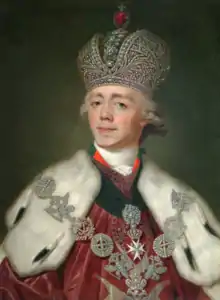 |
| Alexander I Alexander Pavlovich (Alexander the Blessed)
| 23 December 1777 – 1 December 1825 | 23 March 1801 | 1 December 1825 | Son of Paul I and Sophie Dorothea of Württemberg First Romanov King of Poland and Grand Prince of Finland | Holstein-Gottorp-Romanov | .jpg.webp) |
Constantine Pavlovich
| 27 April 1779 – 27 June 1831 | 1 December 1825 | 26 December 1825 | Son of Paul I and Sophie Dorothea of Württemberg Younger brother of Alexander I Uncrowned (abdicated the throne) | Holstein-Gottorp-Romanov | .jpg.webp) |
| Nicholas I Nikolay Pavlovich
| 6 July 1796 – 2 March 1855 | 26 December 1825 | 2 March 1855 | Son of Paul I and Sophie Dorothea of Württemberg Younger brother of Alexander I and Constantine Pavlovich | Holstein-Gottorp-Romanov |  |
| Alexander II Alexander Nikolayevich (Alexander the Liberator)
| 29 April 1818 – 13 March 1881 | 2 March 1855 | 13 March 1881 | Son of Nicholas I and Alexandra Feodrovna Nephew of Alexander I Assassinated | Holstein-Gottorp-Romanov | .jpg.webp) |
| Alexander III Alexander Aleksandrovich (Alexander the Peacemaker)
| 10 March 1845 – 1 November 1894 | 13 March 1881 | 1 November 1894 | Son of Alexander II and Maria Alexandrovna | Holstein-Gottorp-Romanov | .jpg.webp) |
| Nicholas II Nikolay Aleksandrovich
| 18 May 1868 – 17 July 1918 | 1 November 1894 | 15 March 1917 | Son of Alexander III and Maria Feodorovna Abdicated the throne during the February Revolution Murdered by the Bolsheviks | Holstein-Gottorp-Romanov |  |
Pretenders after Nicholas II
Dates after 1918 are in the New Style.
| Name | Lifespan | Reign start | Reign end | Notes | Family | Image |
|---|---|---|---|---|---|---|
Michael Aleksandrovich
| 4 December 1878 – 13 June 1918 | 15 March 1917 | 16 March 1917 | Son of Alexander III Abdicated after a nominal reign of only 18 hours, ending dynastic rule in Russia[4] He is not usually recognised as a tsar, as Russian law did not allow Nicholas II to disinherit his son[5] | Holstein-Gottorp-Romanov |  |
Nikolai Nikolaevich
| 6 November 1856 – 5 January 1929 | 8 August 1922 | 25 October 1922 | Grandson of Nicholas I Proclaimed Emperor of Russia by the Zemsky Sobor of the Provisional Priamurye Government His nominal rule came to an end when the areas controlled by the Provisional Priamurye Government were overrun by the communists | Holstein-Gottorp-Romanov |  |
Kirill Vladimirovich
| 30 September 1876 – 12 October 1938 | 31 August 1924 | 12 October 1938 | Grandson of Alexander II Claimed the title Emperor of All the Russias while in exile[6] Recognised by a congress of legitimists delegates in Paris in 1926[7] | Holstein-Gottorp-Romanov |  |
Leaders after 1917
Timeline of monarchs

See also
Notes
- According to the Tale of Bygone Years, the date is not clearly identified.
References
- Glenn E. Curtis (1996). "Kievan Rus' and Mongol Periods". Russia: A Country Study. Federal Research Division of the Library of Congress. Archived from the original on 27 September 2007. Retrieved 26 November 2013.
- Suszko, Henryk (2003). Latopis hustyński. Opracowanie, przekład i komentarze. Slavica Wratislaviensia CXXIV. Wydawnictwo Uniwersytetu Wrocławskiego. ISBN 83-229-2412-7.
- Tolochko, Oleksiy (2010). The Hustyn' Chronicle. (Harvard Library of Early Ukrainian Literature: Texts) ISBN 978-1-932650-03-7.
- Montefiore, Simon S. (2016) The Romanovs, 1613–1918 London: Weidenfeld & Nicolson, pp. 619–621
- "The Abdication of Nicholas II: 100 Years Later". The Russian Legitimist. Retrieved 30 January 2018.
- Almanach de Gotha (182nd ed.). Almanach de Gotha. 1998. p. 214.
- Shain, Yossi The Frontier of Loyalty: Political Exiles in the Age of the Nation-State University of Michigan Press (2005) p.69.
.svg.png.webp)
.svg.png.webp)

